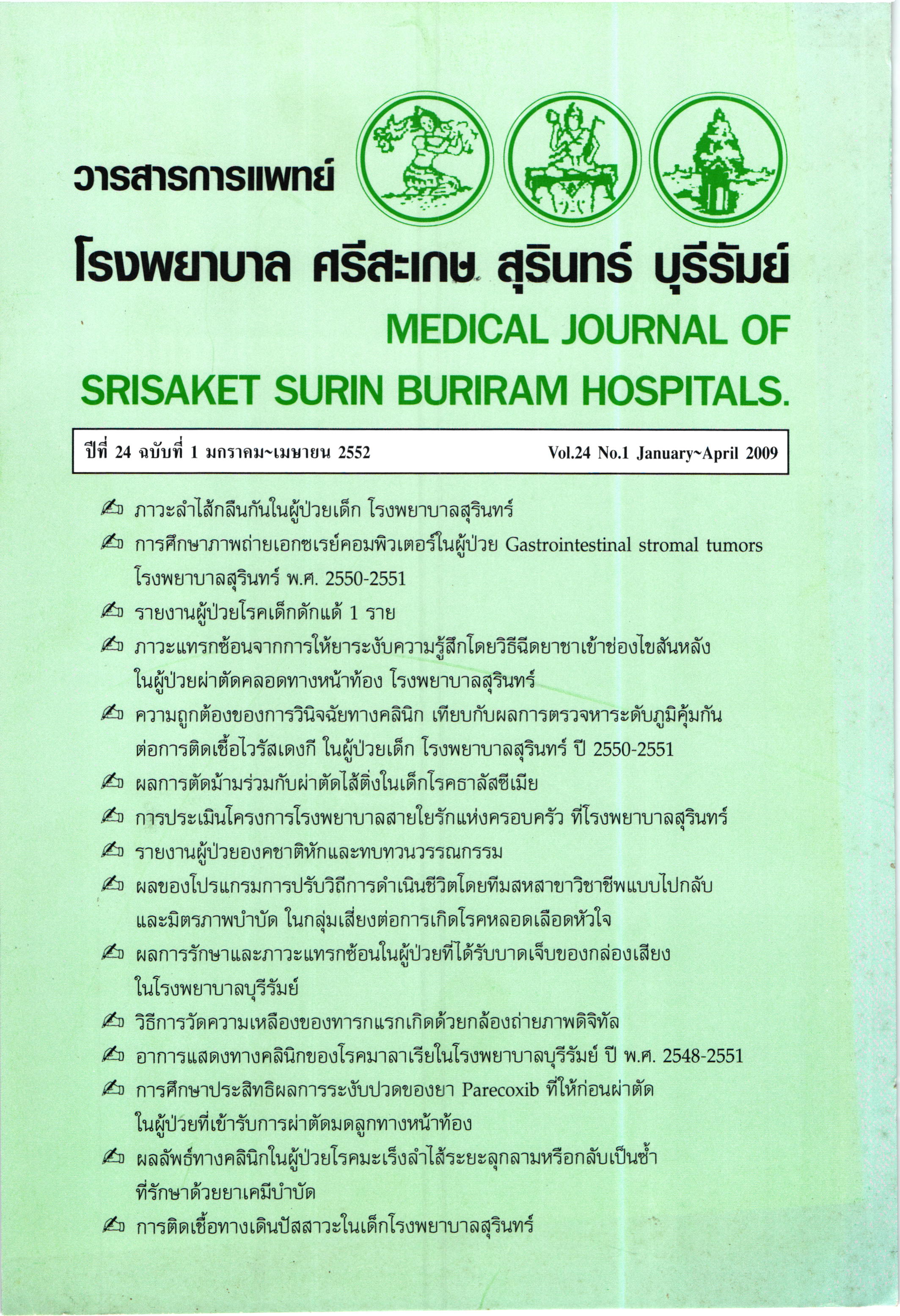การศึกษา เปรียบเทียบขนาดของมอร์ฟีนที่บริหาร ทางช่องไขสันหลัง เพื่อลดความ เจ็บปวด ในผู้ป่วยหลังผ่าตัดคลอด
Main Article Content
บทคัดย่อ
วัตถุประสงค์: เพี่อศึกษาเปรียบเทียบผลการระงับปวดหลังผ่าตัดคลอดและอาการไม่พึงประสงค์ ของ morphine 3 ขนาดที่บริหารทางช่องไขสันหลัง
รูปแบบการวิจัย: Randomized controlled trial (RCT)
สถานที่ศึกษา: ห้องผ่าตัด, หอผู้ป่วยสูติกรรม โรงพยาบาลสุรินทร์
กลุ่มเป้าหมาย: ผู้ป่วยหญิงตั้งครรภ์ครบกำหนด อายุระหว่าง 15-45 ปี ASA physical status I-II ที่มารับการผ่าตัดคลอดที่ห้องผ่าตัด โรงพยาบาลสุรินทร์ จำนวน 102 ราย
วิธีการศึกษา: การศึกษาแบ่งผู้ป่วยเป็น 3 กลุ่ม กลุ่มละ 34 คน โดยวิธีลุ่มตัวอย่าง
กลุ่มที่ 1 ได้ morphine 0.1 mg บริหารทางช่องไขสันหลัง
กลุ่มที่ 2 ได้ morphine 0.2 mg บริหารทางช่องไขสันหลัง
กลุ่มที่ 3 ได้ morphine 0.3 mg บริหารทางช่องไขสันหลัง
ผู้ป่วยจะได้รับการประเมิน VNS, ระยะเวลาที่เริ่มปวด, จำนวน tramal ฉีดทางหลอด เลือดดำ และผลข้างเคียงจากยา morphine (การกดการหายใจ อาการคลื่นไส้, อาเจียน อาการคัน และอาการง่วงซึม) หลังผ่าตัด 24 ชั่วโมง
สถิติ: Oneway anova และ chi-square test
ผลการศึกษา: ข้อมูลทั่วไปของผู้ป่วยทั้ง 3 กลุ่ม ไม่แตกต่างกัน pain free duration ของกลุ่ม 2 และกลุ่ม 3 นานกว่ากลุ่ม 1 อย่างมีนัยสำคัญทางสถิติ, post operative analgesia duration ของกลุ่ม 3 นานกว่ากลุ่ม 1 อย่างมีนัยสำคัญทางสถิติ, จำนวน tramal ที่ผู้ป่วยได้รับในกลุ่ม 1 จะมากกว่ากลุ่ม 3 อย่างมีนัยสำคัญทางสถิติ, VNS ที่ 4, 8, 12 ชั่วโมงหลังผ่าตัดในกลุ่ม 2 และ 3 จะต่ำกว่า กลุ่ม 1 อย่างมีนัยสำคัญทางสถิติ, อัตราการเกิดอาการคลื่นไส้อาเจียน, อาการคันในผู้ป่วยทั้ง 3 กลุ่ม ไม่แตกต่างกัน อย่างมีนัยสำคัญทางสถิติ,ไม่พบอุบัติการณ์ของการกดการหายใจในผู้ป่วยทั้ง 3 กลุ่ม
สรุป: การให้ morphine ทางช่องไขสันหลัง ในขนาด 0.3 mg เพื่อลดความเจ็บปวดหลัง ผ่าตัดคลอด เป็นขนาดที่เหมาะสมที่ให้ผลระงับปวดได้ดี แม้ว่าผลข้างเคียงของยา จะเพิ่มขึ้นตามขนาดของ morphine แต่เป็นอาการที่ไม่รุนแรงและสามารถรักษา ให้หายได้
Key words: การให้ morphine ทางช่องไขสันหลัง การระงับปวดหลังผ่าตัด การผ่าตัดคลอด
Article Details
เอกสารอ้างอิง
2. Abboud TK, Dror A, Mosaad P. et al. Minidoseintrathecal morphine for the relief of post-caesarean section pain : Safety, efficacy and ventilatory responses to carbon dioxide. AnestheAnalg 1988;67:137-43.
3. Gerancher JC, Floyd H, Eisenach J. Determination of an effective dose of intrathecal morphine for pain relief after caesarean delivery. Anesthe Analg 1999;88:346-51.
4. Swart M, Sewell J, Thomas D. Intrathecal morphine for caesarean section : an assessment of pain relief, satisfaction and side effects. Anesthesia 1997;52:373-7.
5. Abouleish E, Rawal N, Salior K, et al. Combindintrathecal morphine and bupivacaine for cesarean section. AnestheAnalg1998;67:370-4.
6. CharuluxanananS, Kyokong O, Pongpak-dee K. Optimal dose of intrathecal morphine for postoperative pain relif in cesarean section. Thai Journal of Anesthesiology 1996;22:82-7.
7. Ratanachai P, Ungkasuwan W. et al. The comparison of intrathecal morphine dosage for post-operative analgesia in cesarean section patients. Thai Journal of Anesthesiology 1996;22:4:247-52.
8. K.C. Lam, S.N.R. Chan, et al. Inrathecal morphine for post-caesarean section analgesia : a comparison of 3 doses. ASEAN Journal of anesthesiology 2004;5:1:10-17.
9. Milner AR, Bogod DG, Harwood RJ. Intrathecal administration of morphine for elective caesarean section. A comparison between 0.1 mg และ 0.2 mg. Anesthesia 1996;51:871-3.
10. Timothy R. Epidural and subarachnoid opiods. In : Michael Ferrante, Timothy R. Vade Boncouer, eds. postoperative pain management. Churchill Livingston : London, 1993;279-303.
11. Raymond S. Sinatra. Postoperative analgesia : Epidural and Spinal Techniques. In: David H. Chestnut, eds. Obstetric anesthesia : Principles and practice. Mosby-YearBook, Inc. : St. Louis, 1994;513-547.


